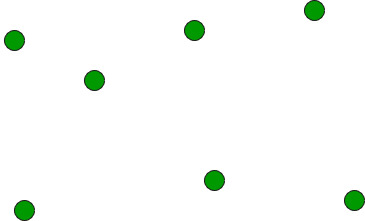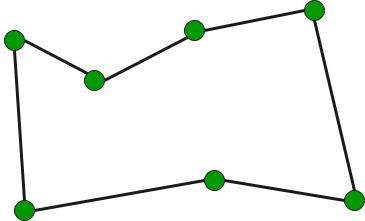给定一组点,连接点而不交叉。
null


例子:
Input: points[] = {(0, 3), (1, 1), (2, 2), (4, 4),
(0, 0), (1, 2), (3, 1}, {3, 3}};
Output: Connecting points in following order would
not cause any crossing
{(0, 0), (3, 1), (1, 1), (2, 2), (3, 3),
(4, 4), (1, 2), (0, 3)}
我们强烈建议您尽量减少浏览器,并先自己尝试。 这个想法是使用排序。
- 通过比较所有点的y坐标找到最底部的点。如果有两个点具有相同的y值,则考虑具有较小x坐标值的点。将最底部的点放在第一个位置。

- 考虑其余的N-1点并用POLR角按点逆时针排序(0)。如果两点的马球角度相同,那么先把最近的一点放在第一位。
- 遍历排序的数组(按角度的递增顺序排序)会产生简单的闭合路径。

如何计算角度? 一种解决方案是使用三角函数。 观察:我们不关心角度的实际值。我们只想按角度排序。 想法:使用 方向 在不计算角度的情况下比较角度!
下面是C++实现上述思想。
C++
// A C++ program to find simple closed path for n points // for explanation of orientation() #include <bits/stdc++.h> using namespace std; struct Point { int x, y; }; // A global point needed for sorting points with reference // to the first point. Used in compare function of qsort() Point p0; // A utility function to swap two points int swap(Point &p1, Point &p2) { Point temp = p1; p1 = p2; p2 = temp; } // A utility function to return square of distance between // p1 and p2 int dist(Point p1, Point p2) { return (p1.x - p2.x)*(p1.x - p2.x) + (p1.y - p2.y)*(p1.y - p2.y); } // To find orientation of ordered triplet (p, q, r). // The function returns following values // 0 --> p, q and r are collinear // 1 --> Clockwise // 2 --> Counterclockwise int orientation(Point p, Point q, Point r) { int val = (q.y - p.y) * (r.x - q.x) - (q.x - p.x) * (r.y - q.y); if (val == 0) return 0; // collinear return (val > 0)? 1: 2; // clockwise or counterclock wise } // A function used by library function qsort() to sort // an array of points with respect to the first point int compare( const void *vp1, const void *vp2) { Point *p1 = (Point *)vp1; Point *p2 = (Point *)vp2; // Find orientation int o = orientation(p0, *p1, *p2); if (o == 0) return (dist(p0, *p2) >= dist(p0, *p1))? -1 : 1; return (o == 2)? -1: 1; } // Prints simple closed path for a set of n points. void printClosedPath(Point points[], int n) { // Find the bottommost point int ymin = points[0].y, min = 0; for ( int i = 1; i < n; i++) { int y = points[i].y; // Pick the bottom-most. In case of tie, chose the // left most point if ((y < ymin) || (ymin == y && points[i].x < points[min].x)) ymin = points[i].y, min = i; } // Place the bottom-most point at first position swap(points[0], points[min]); // Sort n-1 points with respect to the first point. // A point p1 comes before p2 in sorted output if p2 // has larger polar angle (in counterclockwise // direction) than p1 p0 = points[0]; qsort (&points[1], n-1, sizeof (Point), compare); // Now stack has the output points, print contents // of stack for ( int i=0; i<n; i++) cout << "(" << points[i].x << ", " << points[i].y << "), " ; } // Driver program to test above functions int main() { Point points[] = {{0, 3}, {1, 1}, {2, 2}, {4, 4}, {0, 0}, {1, 2}, {3, 1}, {3, 3}}; int n = sizeof (points)/ sizeof (points[0]); printClosedPath(points, n); return 0; } |
输出:
(0, 0), (3, 1), (1, 1), (2, 2), (3, 3), (4, 4), (1, 2), (0, 3),
如果我们对排序点使用O(nLogn)排序算法,则上述解决方案的时间复杂度为O(nLogn)。
资料来源: http://www.dcs.gla.ac.uk/~pat/52233/slides/Geometry1x1。pdf 本文由 拉吉耶夫·阿格拉瓦尔 。如果您发现任何不正确的地方,或者您想分享有关上述主题的更多信息,请发表评论
© 版权声明
文章版权归作者所有,未经允许请勿转载。
THE END


![关于”PostgreSQL错误:关系[表]不存在“问题的原因和解决方案-yiteyi-C++库](https://www.yiteyi.com/wp-content/themes/zibll/img/thumbnail.svg)



